Funky stuff!
Can’t help thinking … canting keel…
have you played with that idea ?
Funky stuff!
Can’t help thinking … canting keel…
have you played with that idea ?
The “delta” foil looks great, as far as curving the foil across the flow, you may want to borrow from aerodynamics, anhedral with the wing tips below the root( inverted V) which tends to be less stable in roll(side to side) or dihedral, wing tips above the root, which should(careful with generalities) be self centering and allow for banking turns without loss of lift ( one half becomes more horizontal, increasing lift, as the other side becomes more vertical, maintaining directional stability and hopefully projecting through the turn).
If you look at the airchair foil, they appear to have anhedral(downward turned wing tips) and a flatter after foil, but they are also using a two element foil, a boat etc.
Following with interest.
Pete
Josh, Dave and Pete, thank you for your replies and this is what I thought of too…

Kinda a bit like what you guys suggested, maybe ?.
The idea is that as it lifts, the horizontal side areas will rise to a certain level and the central, more vertical surfaces will limit any further lift. So it should have good lift at low speed and a lesser increase in lift at higher speeds.
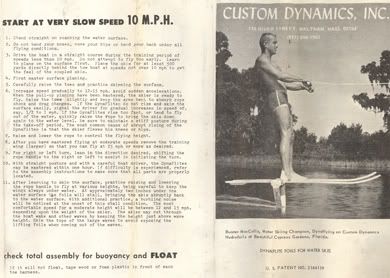
Maybe a flat sided dihedral might work just as well but I’d like to see if the concaved sides have a cupping effect on the rising water. If the flow within the wave face truly comes up the face , then this shape should be more controllable than just a flat plate set perpendicular to the flow and it might harness more of the energy from within the wave too.
It also combines the foil and struts into one piece.
Its just a basic shape but its all I could think of, at the moment.
I’m glad i started this thread. Your experiments are fantastic. Keep it up and keep us informed. Maybe we are witnesses to the next step. And maybe some day, after I figure out thing like how to do things like , oh, gloss coats, or cut laps, I might start experimenting with foils on stand up boards.
Great stuff surffoils!
Maybe you can apply tail design to your foil. put a swallow, round it out, pintail, to allow it to “sit” in the pocket a little instead of wanting to fly out. But maybe adjust the rest of the design to conserve the surface area…have you tried flipping it around the other way? I feel like what you described is a result of all that area at the back of the foil. Is it just a flat piece of wood or did you foil it to some degree (sorry if you already said, I havent read the whole thread)?
Durbs, nice idea there about the tail design. I never thought of that. I reckon that will have a big change in control.I’ll make a few quick ply ones and see if that changes things. What do you think about a big wide triple flyer swallow tail ?
Surfer daves canting keel is a possibility too.
Heres a tow- behind kneeboard from about 15 years ago.
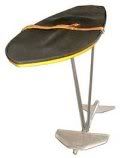
And a range of foils for the airchair for design consideration.

I started with rectangular foils because I think when everyone think of a ‘foil’ they imagine that it has to be something with an exact set of rigid dimensions and hi-spec design, composed of the latest hi-tech composites and expertly foiled down to a micro level of tolerance.
I did mine with standard flat plywood just under a 1/2 in thick, with all the edges rounded with a block and sandpaper, a coat of paint and they work just fine. I never thought it would work in the first place because I thought I was way too low tech, but as my foils do work, then there is a lot of area for improvement in performance with a litle bit more care and skill in construction.
The fact that my genuinely crappy attempts actually fly and turn with control, just shows how much power there is to find under the surface.
I’ll try a few more ply foils for the bodyboard and then I’ll have a go at a stand up board.
Surffoils, your experiments got me thinking… Maybe I should find a garage sale board, maybe a single fin, glass in an extra box between the feet and start experimenting. I’m thinking that leaving a small fin back where the single would go would help directional stability before “take off.”
Better yet, this sounds like a job for AFOAF and the South Bay Laboratories!
I can imagine the look on the groms face’s when I come cruising down the line and then…lift off. That would be classic.
llilibel03, do you think a standard board would be strong enough lengthwise to be lifted out of the water or should I consider making something just for foiling ? Maybe something thick and flat for bouyancy and paddling speed ? Like a stubby windsurfer maybe?

Heres my latest on the foil, a bit of a split single fin, it could mount into FCS plugs. The shapes not exact but you get the idea, anyone seen a split single fin before ?
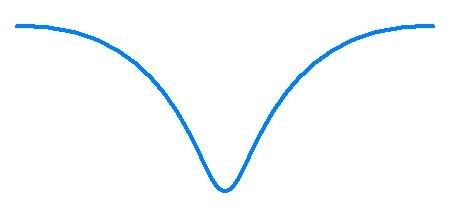
And something different I found…

hmmmm intesting…
If I were going to experiment with this (no time…) I would try to utilize two foils. One in between the feet as you have described that will provide the majority of the lift, and a tail foil to provide lift/trim control and directional control. Just like an airplane. I guess the “airchair” foils seem to be set up that way.
I think the big difference is the case where the foil is in the pocket, with flow at very high angles of attack. dont think the airchair setup would ever encounter this case behind a boat and hence isnt designed for this. But maybe the “advanced/pro” setups are designed for harder turning that could emulate conditions in the pocket of a wave.
Heres a few other home built foilsboards and the fat ass swallow tail I’m trying tomorrow.
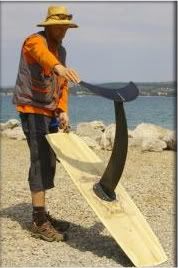
Thats a classic. So basic. 10/10.
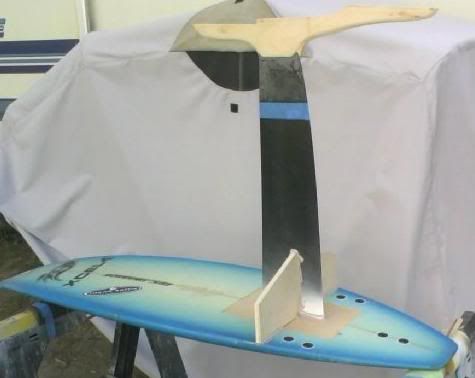
I wonder if the surfboard broke ?

A surfboard, a centreboard, a bit of 9-ply and 2 plastic cutting boards, thats as dodgy as mine.
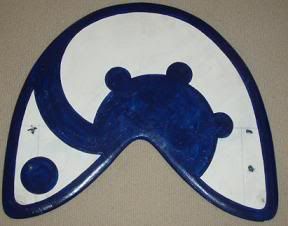
This’ll be fun to test.

Its just flat ply.
Hi Brett -
I was wondering if you had tried altering the vertical struts. I figure they act pretty much as twin fins and provide a lot of drive and stability. In the latest round of photos there is a guy with a hat and what resembles a whale tail on the end of a single strut. Do you think the shape/foil of the struts adds a lot or a little to the equation? My guess is a lot.
I keep thinking of cutting the apex off one of my hoops and adding a flatter planing wing like one of yours.
My initial thoughts when doing the hoops were to allow easy change in angle of attack so I purposely cut the apex down and foiled it thinking it might rotate through the water with less flow disturbance. Obviously for a lifing hydrofoil I’m backassward on that.
I (one of the guilty parties to whom you refer) do imagine some advantage in a molded uni-body strut/foil arrangement - perhaps glassed on but as pointed out, you are getting great results with a simple plywood slab.
In photo below, the designer uses fore and aft hoop foils. Notice how the struts are angled forward on one and swept back on other? A LOT of variables to explore!
[img_assist|nid=1042484|title=hydrofoil|desc=|link=none|align=left|width=640|height=640]
Gee John, I dont know anything anymore. I thought I knew at least a bit about foils after the last few years of testing and theoretical discussion that you were a part of too.
But with the rounded foil lifting more consistently than the rectangular ones I can only guess at whats happening under there and what might work better. At the moment Im swooping along like a longboard but as I get more comfortable and daring Im starting to do floaters and putting in a few snappier arcs. The shape of the wave becomes more important than the surface condition or small shutdowns.
I think Ive scared the poo out of a few surfers when they see me take off and then suddenly lift completely free of the water and cruise along down the line. I can feel them staring at me on the paddle back out. They must be saying " what in the Wide World of Sports is that ??"
The whale tail strut in the pic looks like it would be good for straight line stability with a constant direction of water flow coming at it. The flat metal strip struts Im using seem to add direction, but as they lift up theres less of them in the water and they had less effect at higher speeds to the point where the whole setup felt very squirrelly. When I put the white screw-on aluminium fins on the bottom of the foils, they seem to give a more consistent control. I’d say that any vertical surface below the plane of the foil adds more to consistent control than a similar area above the foil. Maybe its the higher water pressure under the foil.
I saw that your hoops had a lesser chord at the apex but if you were going to try a lifting foil Id go with knocking up some simple vertical struts and a rounded horizontal plate and see how easily it lifts. And then you’ll be plotting how to improve on it too. My foils are very basic but if you could make them with all the special curves and materials Im sure they would move up into the next level of performance.
Yes, love that foilcraft photo too. Foils have become a part of kayaks, water-skis, sailboats, those aquascooter things, powerboats and wind and kite surfers so they will eventually appear on some branded surfcraft somewhere but it is certainly an area with a lot of new possibilities.
Im aiming to make the struts minimal, the foil to become controllable over a wider range of wave shapes and to incorporate some sort of vertical-ish fin surface for hold and drive.
Im still keen on the potential of the curved ‘split single fin’ design.
Wow! I am completely blow away by this thread. I surf in an area that would be a perfect testing ground for these crafts. So…
Are you still proning the board once you catch a wave?
Are you using fins to propel you into the wave or arm power?
I read that Hamilton’s big problem was attaching the foils to the board. How are you currently doing it? Any failures?
Are you catching the wave early, late, or about normal?
My aim would be to take advantage of high tide rolling-type waves that are currently the relm of SUP. Would the foils you’ve used work in these conditions. In other words, how much “power” does it take to get them up and running?
I cannot get over
the impact realities
kelp , debris , human
live and remains
in the way of oncoming
scientists and their progeny.
it will be ok.
it will be of no
consequence
the one legged
surf ski guy never
runs any body over
neither will the 90mph
hydrofoil body boarder.
…ambrose …
just a bundle
of unfounded
blind fear .
looking for places to surf alone
Hi LeeV, to answer your questions.
I cant get it to fly on something less than knee high like this.
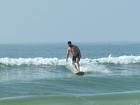
But on something with a face like this and anything bigger, theres no problem.
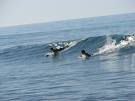
.So it only takes a small wave to have enough energy for the foils to work.
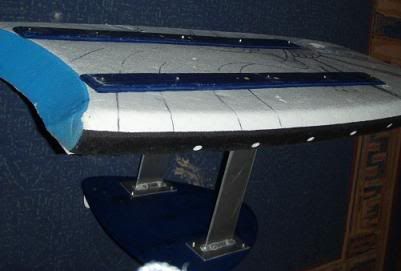
and then Im just using 1 inch wood screws to hold the struts onto the ply.
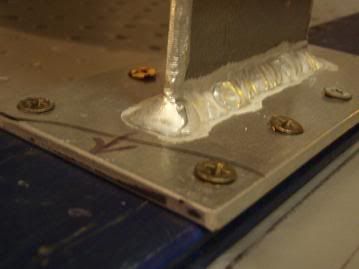
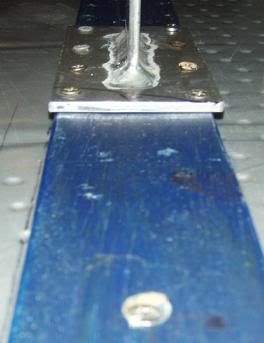

And then bolts to hold the wood foil to the other end of the struts.
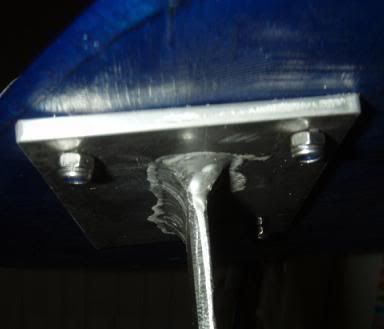
I havent rounded the leading edges on the submerged metal plates so I could make it work better if I just smoothed out the chunky corners and used smaller bolts or recessed the screws properly. I know its poorly done but it was just meant to be a oncer.It all holds together fine, but for a standup board I’d maybe put in a box like llilibel03 said or similar.
I caught waves late to begin with and then early as I figured it out…keep the board flat. On a standup board it shouldnt be a problem. Standup boards have a higher paddling speed so it should be very quick to get lift.
Your waves sound great for foils, as long as theres some level of power in the wave and theres a face. I lost my Navman GPS speed thing in the surf months ago or I’d give you an exact takeoff speed.
I dont think I have found the right shape for the foil at all, Im just sharing whats works at this simple level, but with a bit more testing theres a lot more to get from the wave and make the whole thing a really acceptable way to ride.
Im doing what durbs said about tail shapes and also trying complete ‘mini-surfboard outlines’ as well.
Pics to follow, after Ive tested them.
Are those golf ball-inspired dimples on the bottom?
Its a Morey BCS 42.5 "
So I went with Durbs’s idea of borrowing from surfboard design and I made a foil that can be mounted laterally or lengthways. It makes sense that as a surfboard paddles straight into a wave and then turns 90 degrees at takeoff, so a foil would also need a shape that would effectively handle water flow from a range of directions.
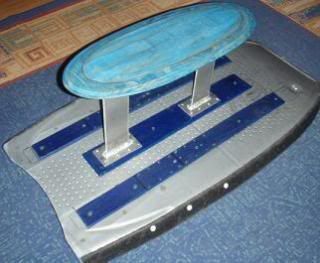
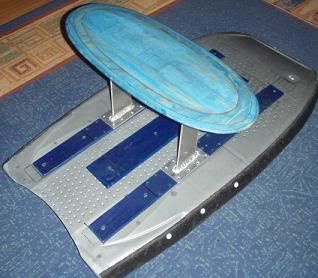
The one lined up lengthways worked best. But I think a delta shape would be better.
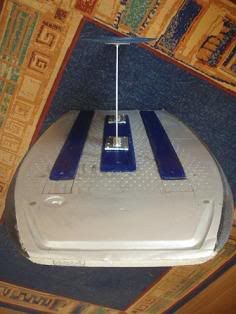
The area of the front of the foil seems to be important for regulating the pitch control and the overall length controls how smoothly it rides.
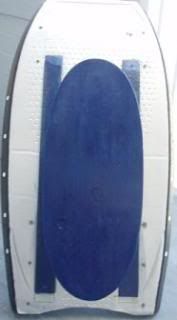
The one above is 23 X 9 in wide and I thought that when it lifted it would wobble side to side like a man on stilts but it was perfectly stable. It was so stable that I was doing late drops on the biggest waves I could find and with no fear about control. Its 180 square inches in area and thats a little too small for the generic beach breaks I tried, more area would give it more run out onto the face.
The turning control appears to be from the back end of the foil and the rounded tail was able to turn easily and smoothly but it made the board lose power quicker, so I would say a wider tail would keep lift and drive. Either a straight trailing edge or with a mild concave / convex. Nothing too tapered.
Something with a bit of length in both dimensions would begin to have benefits in all areas, maybe this shape or something like this.
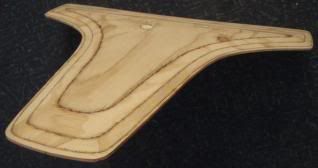


I’ll try this one and then do some more thinking.
Fascinating stuff, I love seeing these ideas going straight form concept to test, it’s inspiring. Thaks for sharing and please keep them coming. I can’t wait for the next post.
you are operating on an entirely different plane.
yuk yuk!
seriously though, unreal.